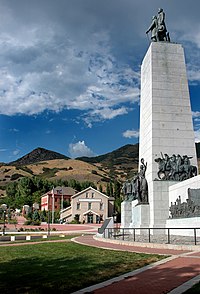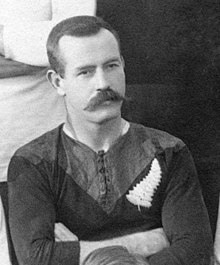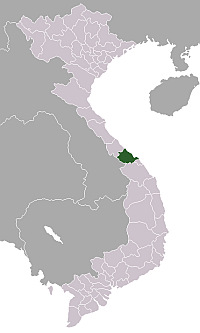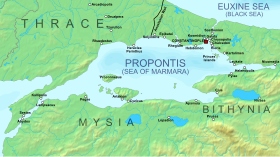Portal:History
The History Portal
History (derived from Ancient Greek ἱστορία (historía) 'inquiry; knowledge acquired by investigation') is the systematic study and documentation of human past. History is an academic discipline which uses a narrative to describe, examine, question, and analyze past events, and investigate their patterns of cause and effect. Historians debate which narrative best explains an event, as well as the significance of different causes and effects. Historians debate the nature of history as an end in itself, and its usefulness in giving perspective on the problems of the present.
The period of events before the invention of writing systems is considered prehistory. "History" is an umbrella term comprising past events as well as the memory, discovery, collection, organization, presentation, and interpretation of these events. Historians seek knowledge of the past using historical sources such as written documents, oral accounts or traditional oral histories, art and material artifacts, and ecological markers. History is incomplete and still has debatable mysteries.
Stories common to a particular culture, but not supported by external sources (such as the tales surrounding King Arthur), are usually classified as cultural heritage or legends. History differs from myth in that it is supported by verifiable evidence. However, ancient cultural influences have helped create variant interpretations of the nature of history, which have evolved over the centuries and continue to change today. The modern study of history is wide-ranging, and includes the study of specific regions and certain topical or thematic elements of historical investigation. History is taught as a part of primary and secondary education, and the academic study of history is a major discipline in universities.
Herodotus, a 5th-century BCE Greek historian, is often considered the "father of history", as one of the first historians in the Western tradition, though he has been criticized as the "father of lies". Along with his contemporary Thucydides, he helped form the foundations for the modern study of past events and societies. Their works continue to be read today, and the gap between the culture-focused Herodotus and the military-focused Thucydides remains a point of contention or approach in modern historical writing. In East Asia a state chronicle, the Spring and Autumn Annals, was reputed to date from as early as 722 BCE, though only 2nd-century BCE texts have survived. The title "father of history" has also been attributed, in their respective societies, to Sima Qian and Ibn Khaldun. (Full article...)

The Holocaust in Slovakia was the systematic dispossession, deportation, and murder of Jews in the Slovak Republic, a client state of Nazi Germany, during World War II. Out of 89,000 Jews in the country in 1940, an estimated 69,000 were murdered in the Holocaust.
After the September 1938 Munich Agreement, Slovakia unilaterally declared its autonomy within Czechoslovakia, but lost significant territory to Hungary in the First Vienna Award, signed in November. The following year, with German encouragement, the ruling ethnonationalist Slovak People's Party declared independence from Czechoslovakia. The Slovak government blamed the Jews for the territorial losses. Jews were targeted for discrimination and harassment, including the confiscation of their property and businesses. The exclusion of Jews from the economy impoverished the community, which encouraged the government to conscript them for forced labor. On 9 September 1941, the government passed the Jewish Code, which it claimed to be the strictest anti-Jewish law in Europe. (Full article...)
On 9 February 1945, a force of Allied Bristol Beaufighter aircraft suffered many losses during an attack on the German destroyer Z33 and its escorting vessels; the operation was called Black Friday by the survivors. The German ships were sheltering in a strong defensive position in Førde Fjord, Norway, forcing the Allied aircraft to attack through massed anti-aircraft fire (FlaK).
The Beaufighters and their escort of Mustang Mk III fighters from 65 Squadron RAF were intercepted by twelve Focke-Wulf Fw 190s of Jagdgeschwader 5 (Fighter Wing 5) of the Luftwaffe. The Allies damaged at least two of the German ships for the loss of seven Beaufighters shot down by FlaK. Two Beaufighters and a Mustang were shot down by the Fw 190s and four or five of the German aircraft were shot down by the Allied aircraft, including that of the ace Rudi Linz. (Full article...)
Western Ganga was an important ruling dynasty of ancient Karnataka in India which lasted from about 350 to 1000 CE. They are known as "Western Gangas" to distinguish them from the Eastern Gangas who in later centuries ruled over Kalinga (modern Odisha and Northern Andhra Pradesh). The general belief is that the Western Gangas began their rule during a time when multiple native clans asserted their freedom due to the weakening of the Pallava empire in South India, a geo-political event sometimes attributed to the southern conquests of Samudra Gupta. The Western Ganga sovereignty lasted from about 350 to 550 CE, initially ruling from Kolar and later, moving their capital to Talakadu on the banks of the Kaveri River in modern Mysore district.
After the rise of the imperial Chalukyas of Badami, the Gangas accepted Chalukya overlordship and fought for the cause of their overlords against the Pallavas of Kanchi. The Chalukyas were replaced by the Rashtrakutas of Manyakheta in 753 CE as the dominant power in the Deccan. After a century of struggle for autonomy, the Western Gangas finally accepted Rashtrakuta overlordship and successfully fought alongside them against their foes, the Chola Dynasty of Tanjavur. In the late 10th century, north of Tungabhadra river, the Rashtrakutas were replaced by the emerging Western Chalukya Empire and the Chola Dynasty saw renewed power south of the Kaveri river. The defeat of the Western Gangas by Cholas around 1000 resulted in the end of the Ganga influence over the region. (Full article...)
The first Arab siege of Constantinople in 674–678 was a major conflict of the Arab–Byzantine wars, and the first culmination of the Umayyad Caliphate's expansionist strategy towards the Byzantine Empire, led by Caliph Mu'awiya I. Mu'awiya, who had emerged in 661 as the ruler of the Muslim Arab empire following a civil war, renewed aggressive warfare against Byzantium after a lapse of some years and hoped to deliver a lethal blow by capturing the Byzantine capital of Constantinople.
As reported by the Byzantine chronicler Theophanes the Confessor, the Arab attack was methodical: in 672–673 Arab fleets secured bases along the coasts of Asia Minor, and then proceeded to install a loose blockade around Constantinople. They used the peninsula of Cyzicus near the city as a base to spend the winter, and returned every spring to launch attacks against the city's fortifications. Finally, the Byzantines, under Emperor Constantine IV, managed to destroy the Arab navy using a new invention, the liquid incendiary substance known as Greek fire. The Byzantines also defeated the Arab land army in Asia Minor, forcing them to lift the siege. The Byzantine victory was of major importance for the survival of the Byzantine state, as the Arab threat receded for a time. A peace treaty was signed soon after, and following the outbreak of another Muslim civil war, the Byzantines even experienced a brief period of ascendancy over the Caliphate. The siege was the first major Arab defeat in 50 years of expansion and temporarily stabilized the Byzantine Empire after decades of war and defeats. (Full article...)
Featured picture
Did you know (auto generated)

- ... that Voyager 2 has been transmitting data for more than 46 years, making it the oldest active space probe in history?
- ... that the 2022 Boca Raton Bowl was the first bowl game loss in Liberty program history after three wins in their first three appearances?
- ... that West Auckland is home to the largest stratovolcano in the geologic history of New Zealand?
- ... that Montenegrin historian Radoje Pajović refused to engage in historical revisionism to rehabilitate Chetniks who collaborated with the Axis powers?
- ... that a historian lamented the lack of English-language translations for the work of Aracy Amaral despite it being "a vital reference for the study of art history in Brazil"?
- ... that Yesenia Yarhui, the youngest parliamentarian in Bolivian history, was sworn into the Chamber of Deputies at just 19 years old?
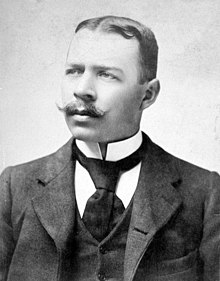
Carsten Egeberg Borchgrevink (1 December 1864 – 21 April 1934) was a Norwegian polar explorer and a pioneer of Antarctic travel. He inspired Sir Robert Falcon Scott, Sir Ernest Shackleton, Roald Amundsen, and others associated with the Heroic Age of Antarctic Exploration.
Borchgrevink was born and raised in Christiania (now Oslo) as the son of a Norwegian lawyer and an English-born immigrant mother. He began his exploring career in 1894 by joining a Norwegian whaling expedition, during which he became one of the first people to set foot on the Antarctic mainland. This achievement helped him to obtain backing for his Southern Cross expedition, which became the first to overwinter on the Antarctic mainland, and the first to visit the Great Ice Barrier since the expedition of Sir James Clark Ross nearly sixty years earlier. (Full article...)On this day
- 1236 – Livonian Crusade: The Livonian Brothers of the Sword were soundly defeated by pagan Samogitian and Semigallian troops at the Battle of Saule.
- 1789 – The office of United States Postmaster General was formally established.
- 1957 – François Duvalier (pictured), nicknamed Papa Doc, was elected President of Haiti as a populist before consolidating power and ruling as a dictator for the rest of his life.
- 2003 – Dolphin, the first emulator for the GameCube that could run commercial video games, was released.
- 2013 – Insurgency in Khyber Pakhtunkhwa: All Saints Church in Peshawar, Pakistan, was attacked by two suicide bombers who killed 127 people.
- Ibn Khallikan (b. 1211)
- Louise McKinney (b. 1868)
- Ice Box Chamberlain (d. 1929)
- Florence Merriam Bailey (d. 1948)
Selected quote
Even as the fingers of the two hands are equal, so are human beings equal to one another. No one has any right, nor any preference to claim over another. You are brothers.
— Muhammad, 7th century Islamic prophet
Related portals
More Did you know...
- ... that, when Ghenadie Petrescu (pictured) was ousted from his post of Metropolitan-Primate, Romania experienced protests and riots?
- ... that the British destroyer HMS Highlander escorted Convoy SC 122 through the largest convoy battle of World War II in March 1943 and was unsuccessfully attacked by U-441 and U-608?
- ... that in 1911, John Gaunt's second biplane nearly crashed because a bystander bent the aircraft's elevator before a flight?
- ... that Themistokli Gërmenji, an Albanian nationalist, received the French Croix de Guerre in November 1917, but was executed shortly thereafter by a French military court?
- ... that fish-knives inscribed with Elokeshi's name were sold after her husband decapitated her with a fish-knife following her adulterous affair with a Hindu head-priest?
- ... that the ancient Roman dancer Galeria Copiola reached the age of 104?
- ... that to escape burning at the 1393 Bal des Ardents Charles VI of France huddled under the gown of the Duchesse de Berry, while a lord leaped into a wine vat?
- ... that a junior officer on the USS Ancon refused King George VI entry to the ship's intelligence centre because no one told him the King "was a Bigot"?
Topics
Categories

History • By period • By region • By topic • By ethnic group • Historiography • Archaeology • Books • Maps • Images • Magazines • Organizations • Fictional • Museums • Pseudohistory • Stubs • Timelines • Chronology • People • Wikipedia historians
WikiProjects
![]() WikiProject History •
Ancient Near East • Australian History • Classical Greece and Rome • Dacia • Former countries • History of Canada • Chinese history • European history • Heraldry and vexillology • Indian history • Jewish history • Medieval Scotland • Mesoamerica • Military history • Middle Ages • History of Science
WikiProject History •
Ancient Near East • Australian History • Classical Greece and Rome • Dacia • Former countries • History of Canada • Chinese history • European history • Heraldry and vexillology • Indian history • Jewish history • Medieval Scotland • Mesoamerica • Military history • Middle Ages • History of Science
WikiProject Time • Days of the Year • Years
WikiProject Biography • Composers • Political figures • Saints • United States Presidents
Things you can do
 |
Here are some tasks awaiting attention:
|
Associated Wikimedia
The following Wikimedia Foundation sister projects provide more on this subject:
-
Commons
Free media repository -
Wikibooks
Free textbooks and manuals -
Wikidata
Free knowledge base -
Wikinews
Free-content news -
Wikiquote
Collection of quotations -
Wikisource
Free-content library -
Wikiversity
Free learning tools -
Wiktionary
Dictionary and thesaurus

